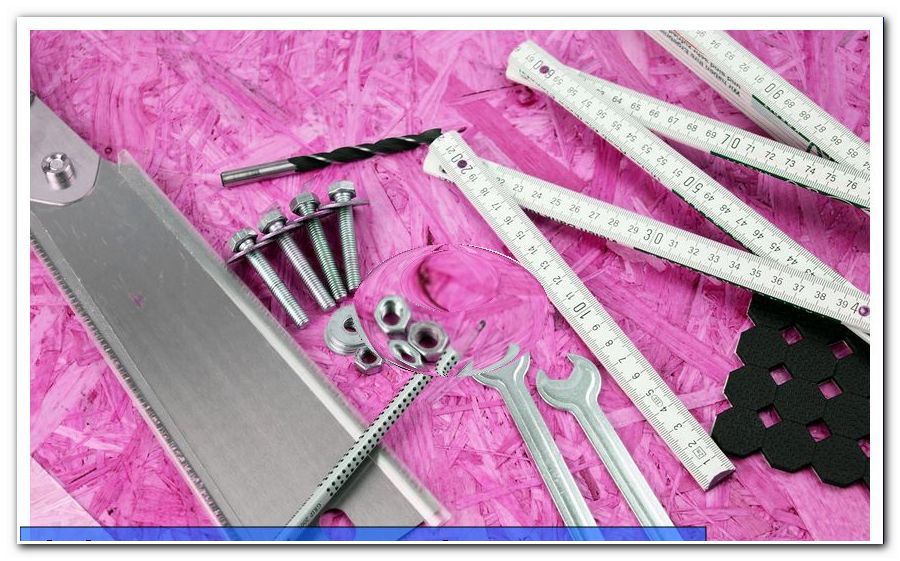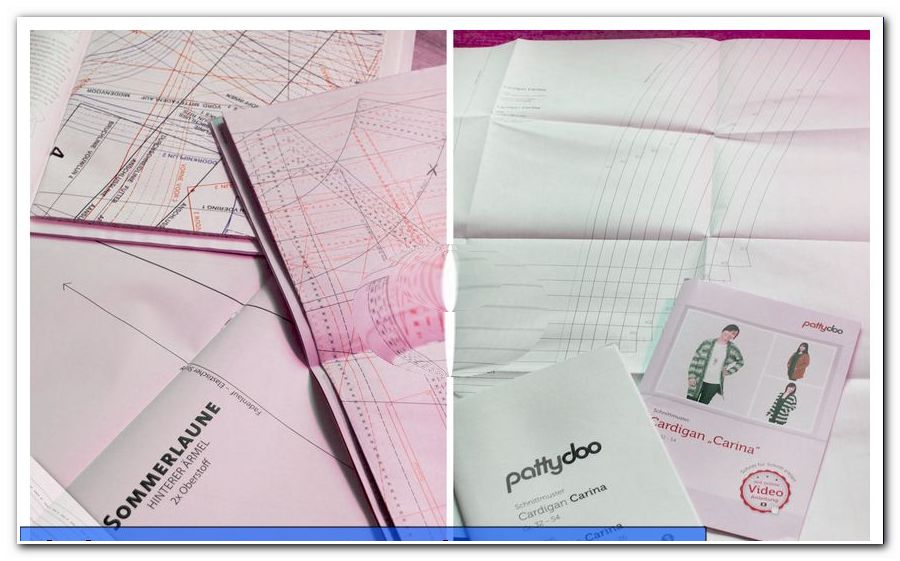Making Rainmakers - 3 simple DIY tutorials for kids

- From the chip box to the rainmaker
- Rainmaker with nails
- Fast rainmaker made of aluminum foil
Rainmakers are originally from South America and are made from cacti by the locals. Since you probably will not find enough cacti on your doorstep, these three guides provide wonderful alternatives for quick and easy rainmakers. The results can be seen and heard!
For me it's supposed to rain nice sounds: make rainmaker yourself
The soothing sound of rain pattering on the window panes fascinates both adults and children: rainmakers generate exactly this sound, even in good weather. Our three multi-faceted instructions show you, step by step, simple ways to create this atmospheric instrument yourself. In addition to variable design options, the difference lies mainly in the inner life: this is once formed of wire, alternatively consists of aluminum foil or is produced by pierced nails. For each of the rainmakers you need little more than you most likely have in the household anyway. In any case, this is a great crafting idea for children on rainy days.
From the chip box to the rainmaker
From the typical stack chips can be quickly and easily create imaginative rainmakers. The classic approach is based on the South American original instruments and is based on the piercing of the outer shell. For this you will find a manual in variant 2. Here we want to keep the difficulty very low, so that children could participate directly or even start alone!
Difficulty: Very easy to copy
Time required: 15 minutes to half an hour, depending on the skill
Material costs: under 5 euros
You need this:
- an empty stack of chips (such as "Pringles")
- a roll of wire (most likely flower-tied wire)
- Wrapping paper (especially beautiful in rainbow colors or with aquatic rain motives)
- a handful of beans
- a handful of rice
- Tape or washi tape
- craft glue
- Scissors or better: side cutter
- Ruler or tape measure
- pencil
How to proceed:
1. First twist several spirals with the wire: To do this, place the beginning of the wire around one finger and wrap more and more wire around it. After about 10 to 15 wraps release a few inches and then form the next spiral.
Tip: You do not cut the wire in between, but always work on the same wire thread.
2. Repeat this step until you have formed enough spirals to fill the chip box solid from top to bottom - or until about half of your wire roll is used up.
Tip: The sound then becomes especially beautiful when you create spirals of different sizes. You can do this by varying the number of wrapped fingers. Start with one and turn the next spiral by two or three fingers, while for the second one the whole hand will be wound with wire.
3. Once the roll is "on the wire", you can pour your beans and rice into the can.

4. Now close your future rainmaker with the lid and do the sound test: like the result ">
Tip: The rice grains produce the sound of gentle raindrops while the beans sound more like heavy hail.
5. Now glue the lid to the tape or washi tape. Simply lay clean all around - the more carefully you work, the better the result will look in the end.
6. And it's time to decorate: Measure a piece of your gift paper, which is high and wide enough to completely cover the chip can.

7. You also need two circles that cover the bottom and top of the can. The can itself serves as a template. Simply draw the outer round contours from one side with the pencil and you should get two circles of the same size.
8. Coat the entire tin, including the top and bottom, with craft glue and use it to attach your wrapping paper. Place it nicely clean, press down well, let it dry - and voilà!
Tip: For children, you could also add smiling suns and clouds to the finished rainmaker. Simply cut out of yellow and blue-gray cardboard paper, paint faces with a felt-tip pen and attach as desired with a glue stick.
Rainmaker with nails
Of course, the longer the rainmaker, the longer it takes to have his wonderfully relaxing sound - because the sound materials have to travel a long way. So he should be long, so we have decided here for a wrapping paper as the main ingredient. If you only have shorter alternatives in the house, you can of course also resort to the kitchen roll or back to the chip box. This time it goes to the production, which comes closest to the traditional rainmakers.
Difficulty: slightly more extensive than Variant 1, but still easy!
Time required: about 30 minutes
Material costs: less than 5 euros, as most of them are already present in the household
You need this:
- a long empty roll of wrapping paper (as stable as possible)
- Thumbtack (or a pin from a pin board)
- about half a cup of nails (medium sized, no longer than the radius of your gift roll)
- Washi Tape (in exotic wilderness or animal patterns - for the South American flair)
- Insulating tape (matching the washi tape) and matching decorative material
- aluminum foil
- a cup of rice
How to proceed:
1. First, pierce the wrapping paper roll with the thumbtack in a spiral pattern. For some rolls, the seam will tighten accordingly so you can orient yourself. Otherwise just by eye, the spiral does not have to be absolutely accurate. The hole spacing should be about one centimeter.
Tip: For gift rolls made of very thin cardboard, the tingling needle is superfluous. In this case, the nails can be easily pierced directly!
2. Insert one of your nails into each hole.
Tip: The tighter the nails are, the softer the subsequent sound. However, the rice grains should still fit well through the gaps - otherwise there is a rainstorm!
3. Now cover one end of the roll with a piece of aluminum foil and fix it tightly with insulating tape. Do this several times around and quietly over the outer circle.

4. Since one side of the rainmaker is now well closed, the rice may enter. First take a tablespoon and then increase the amount until you like the sound the best.
Tip: For the sound test, just hold the open side with one hand and let your near-finished rainmaker make its unmistakable sound by slowly bringing it to a tilt.
5. Close the second page as in step 3.
6. Then wrap the entire roll evenly from top to bottom with the colored insulating tape, which ensures stability! Tighten it a bit, then it can be placed exactly as desired. Make sure that the edges overlap slightly and do not close with each other or leave gaps between them.
7. The Washi Tape now serves as a decoration: apply a few streaks to taste or round the entire rainmaker with it. Also do not forget the outer circles!
Tip: Two or three alternate Washi Tape types make for a very nice look - but as always, that's up to you.
Fast rainmaker made of aluminum foil
Anyone who can not wait for the rain - or at least the noise - will reach the finish with this extremely fast and simple variant in a flash, and with a minimum of materials. This high-speed rainmaker is therefore also perfect for those who first want to watch and, above all, want to hear whether they can even do anything with the instrument.
Difficulty: the easiest of all
Time required : done with a little dexterity in 10 minutes
Material costs: less than 2 euros - should actually be in the household in stock
You need this:
- Empty kitchen roll or empty stack chip box
- aluminum foil
- half a cup of rice (or lentils, or sesame, or anything else of similar size)
- Craft glue or hot glue gun
- scissors
- 2 - 4 rubber bands or pretty: Washi Tape
How to proceed:

1. First, cut a piece of aluminum foil that is tall and wide enough to completely encase the entire roll.
2. Now paint the empty roll with craft glue or draw a thin line with the hot glue gun.
3. Now glue the piece of film on the outside of your roll so that it is completely covered and no cardboard is visible.
Tip: Accentuately negligent and with many untidy wrinkles, the result may look just as good as it is perfectly clean and mirror-smooth.
4. Cover one of the open ends with foil, so that the circular opening is covered well and taut afterwards. Stick the film to the outside with Washi Tape. If you need to go extra fast, you can also simply pull one or two rubber bands over it.
5. Now pick up the aluminum foil again. This time, you are forming a spiral from an A4-sized piece.
6. Repeat step 5 and then loosely twist both spirals together.
7. Insert your spiral construct into the now silver tube and then pour in the rice.
8. Finally, just close your rainmaker as you did in step 4. Done! Of course, if you feel like it, you can also decorate this version with Washi Tape or Loom Bands.
Tips for quick readers:
- Rainmaker from stacked chip box and wire
- Roll up the wire in a spiral and push it into a box
- Different sized spirals for optimal sound
- Add sound material until the sound falls
- Glue the lid and decorate with wrapping paper
- Rainmaker from gift roll with nails
- Spiral nails into the roll
- Bond the opening with foil and insulating tape
- Fill in the sound material, close the second opening as well
- Wrap completely with insulating tape
- Decorate with exotic washi tape
- Fast rainmaker with aluminum foil
- Slide spiral-shaped aluminum foil into kitchen roll
- Cover empty kitchen roll outside with aluminum foil
- Fill in sound material, seal with aluminum foil on both sides





